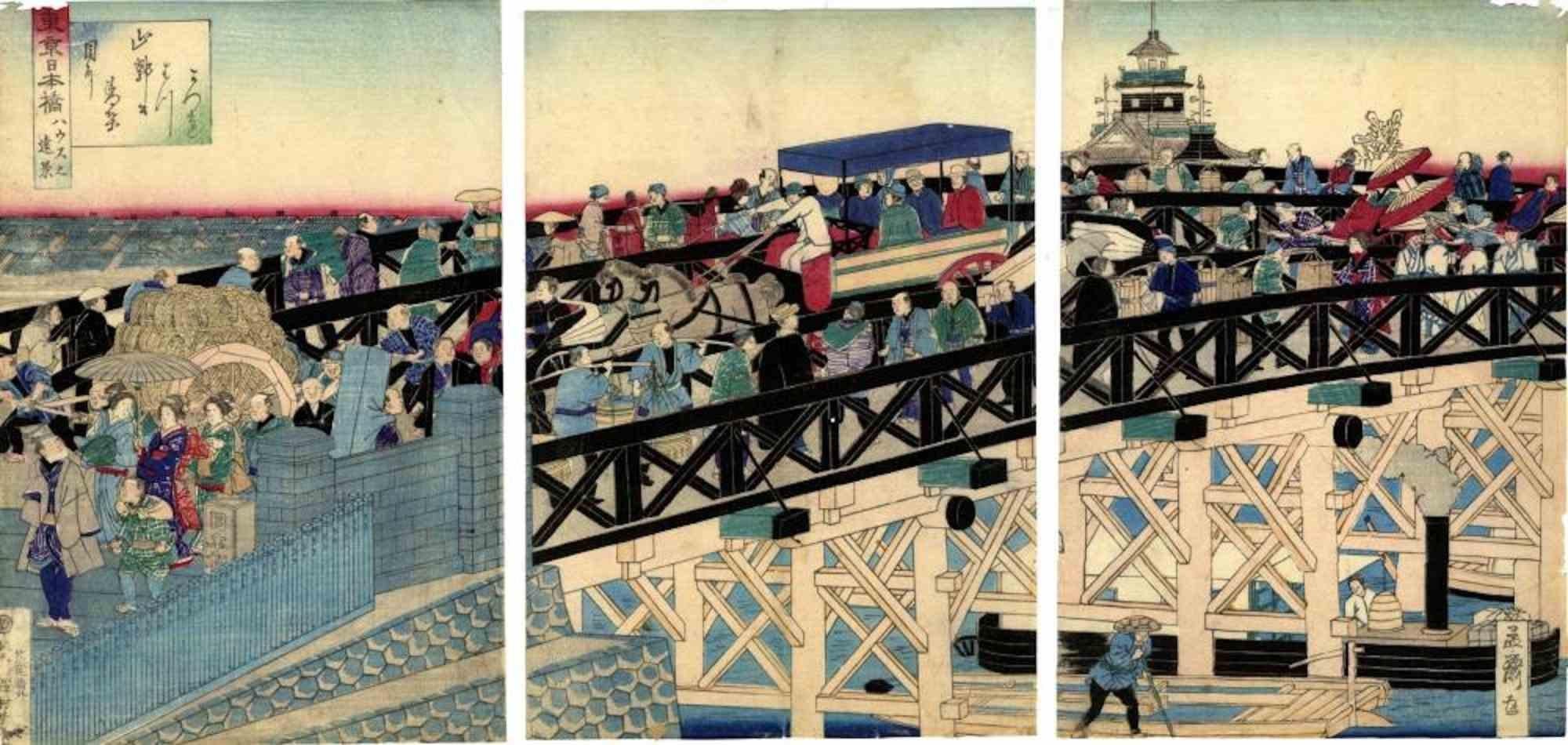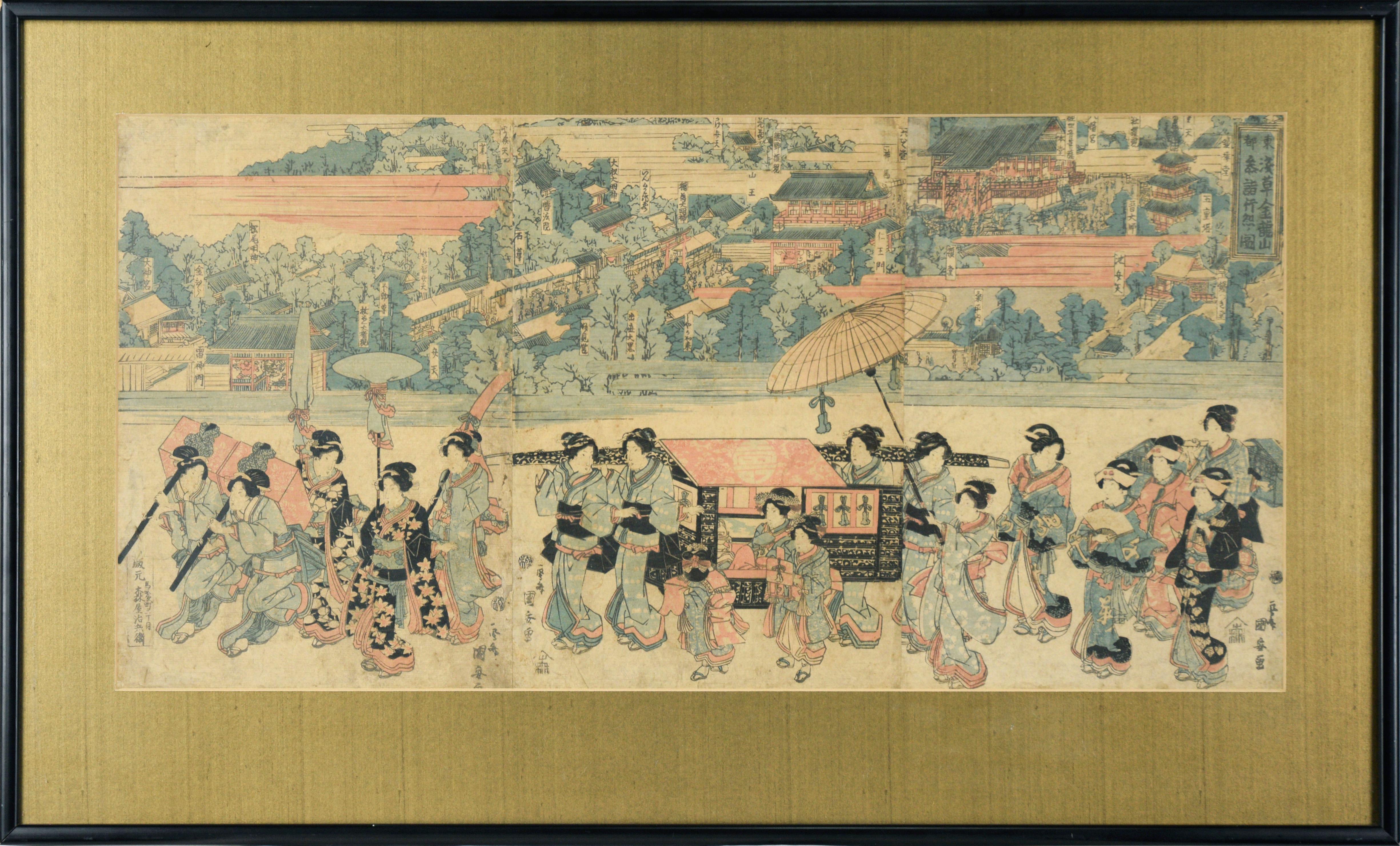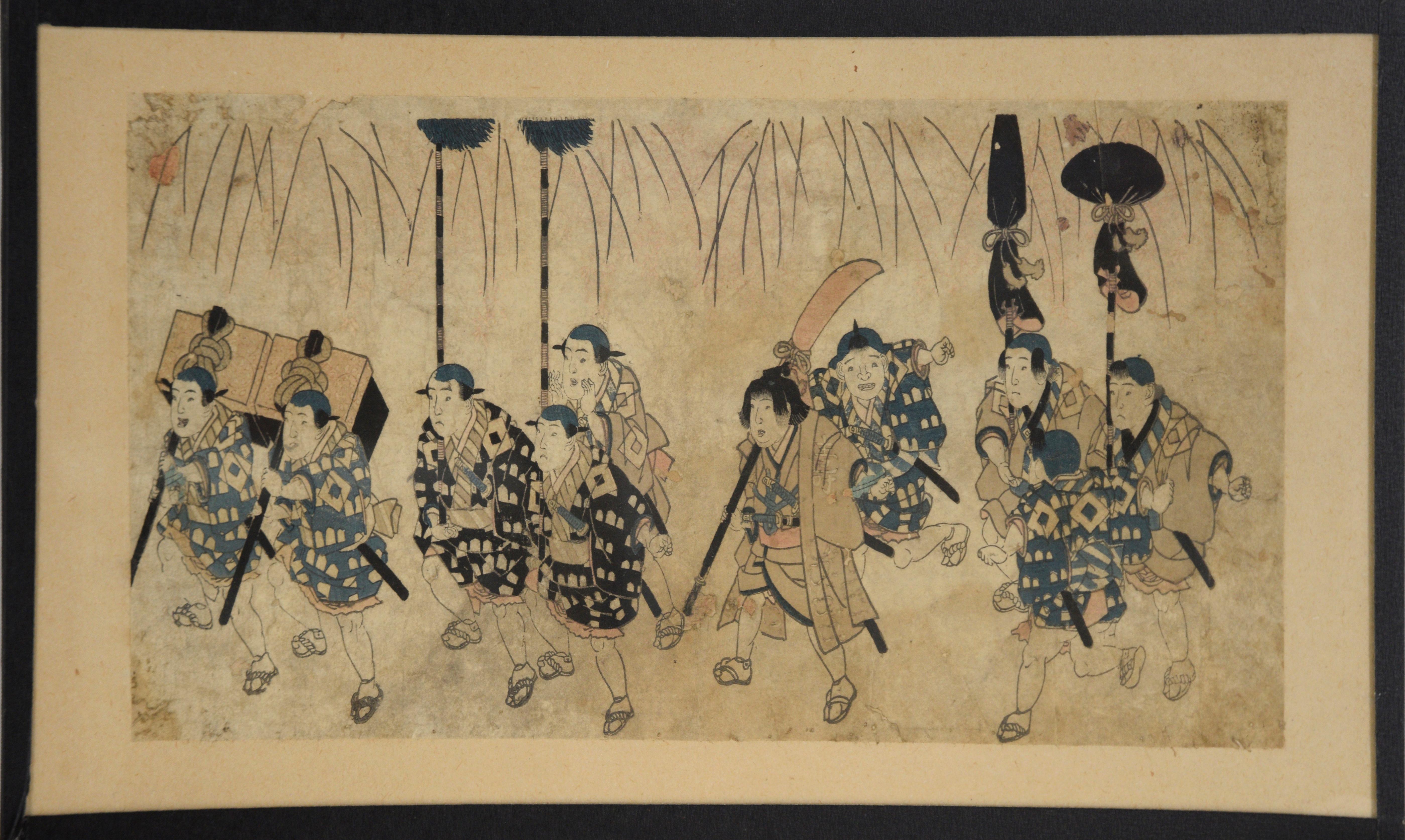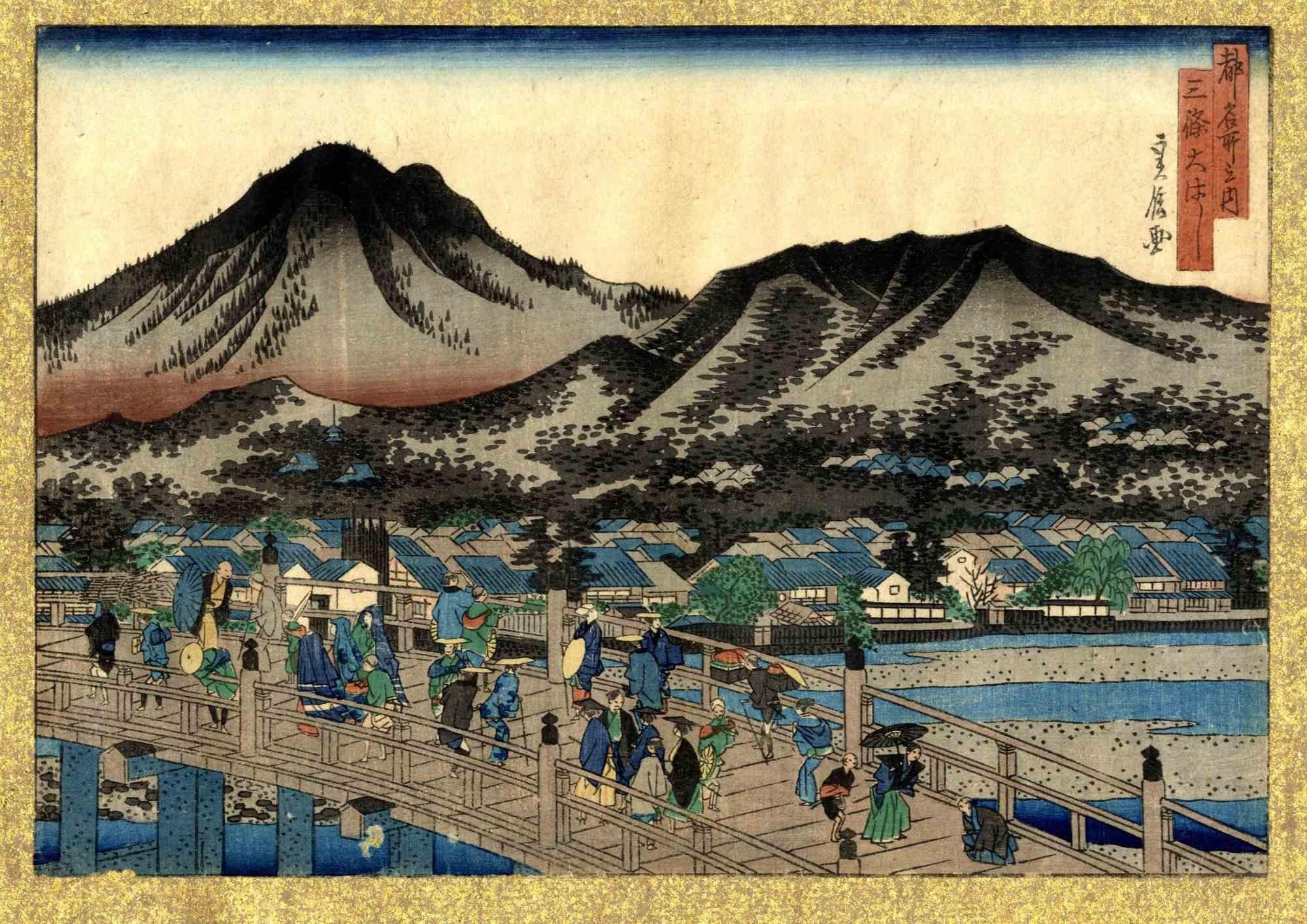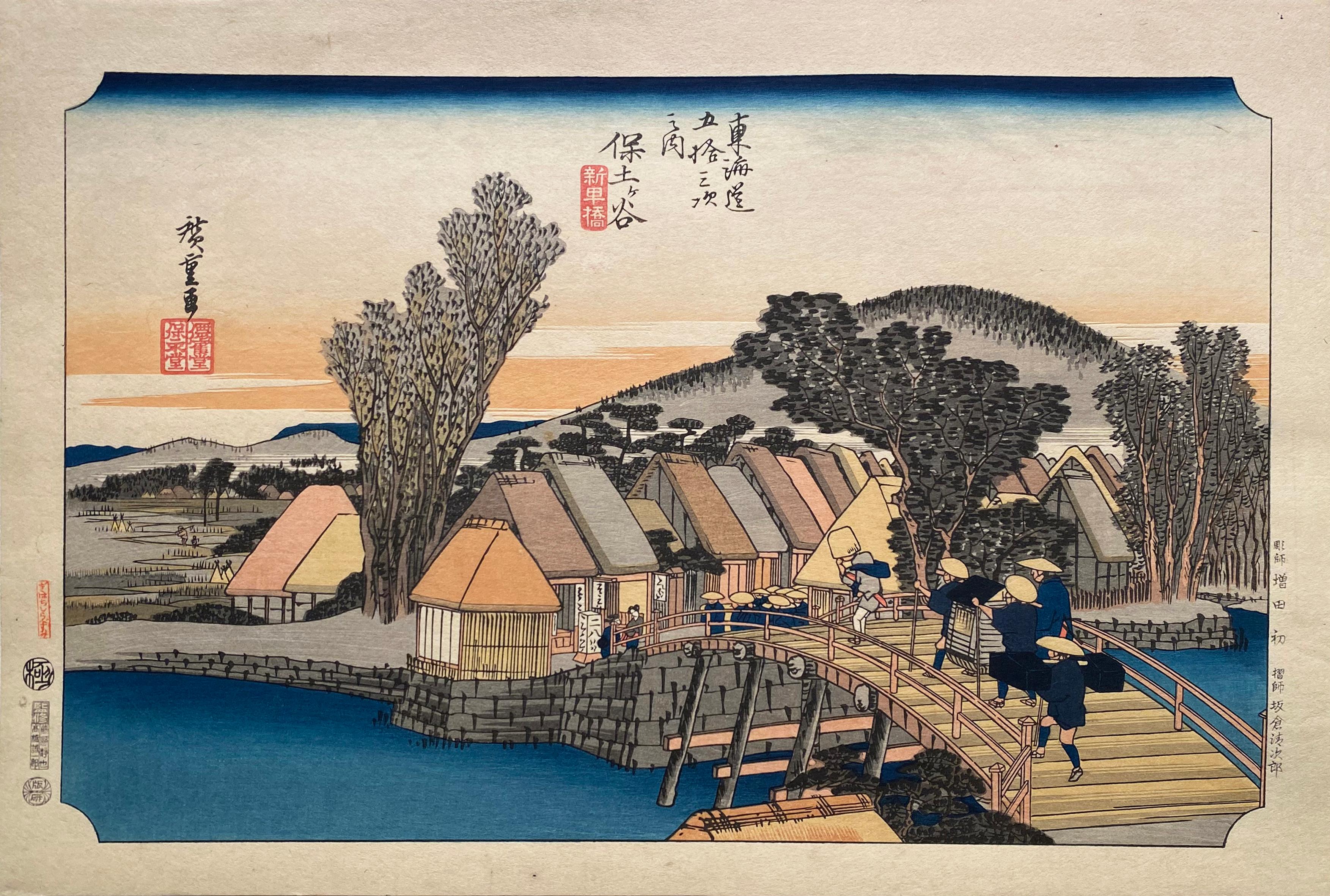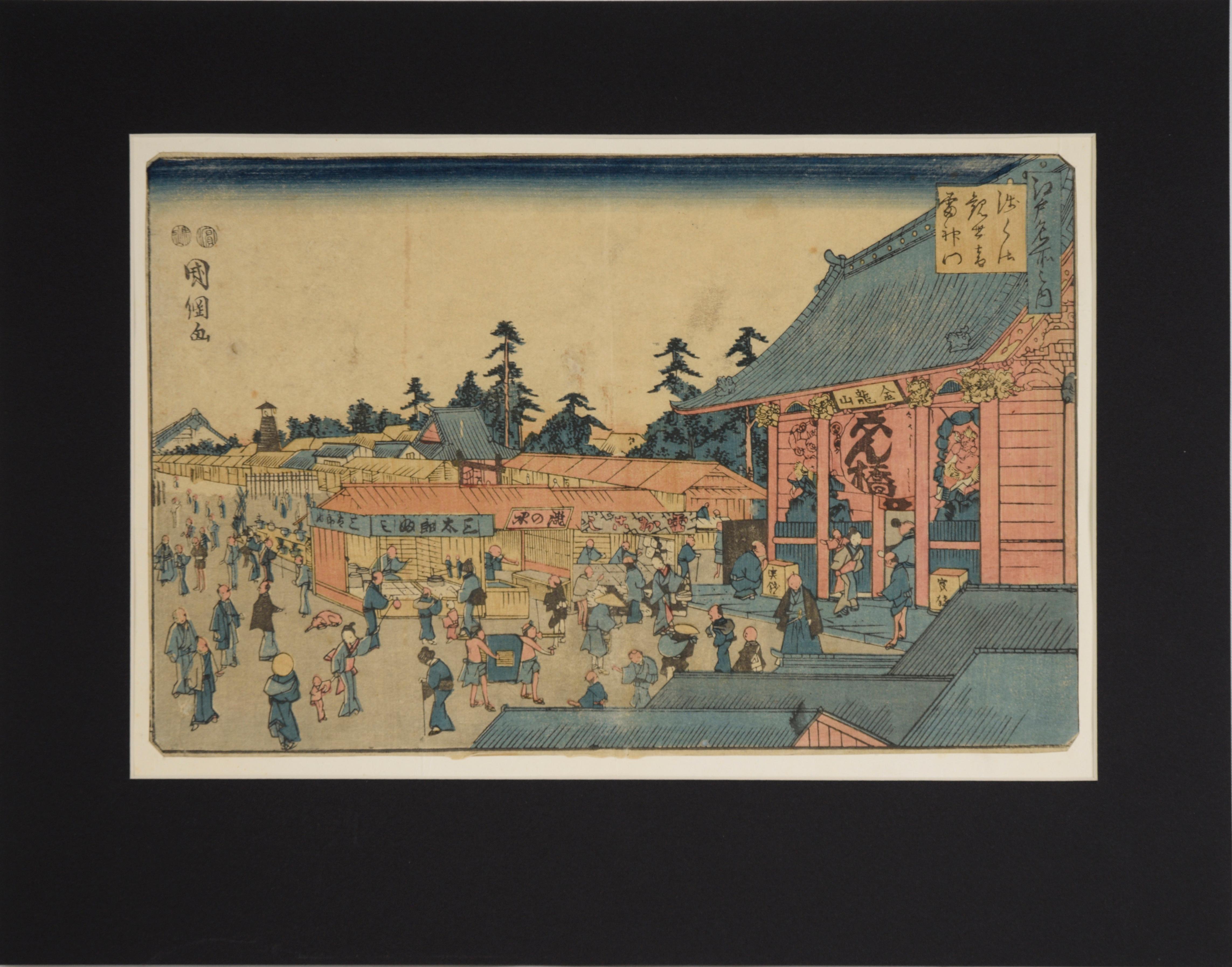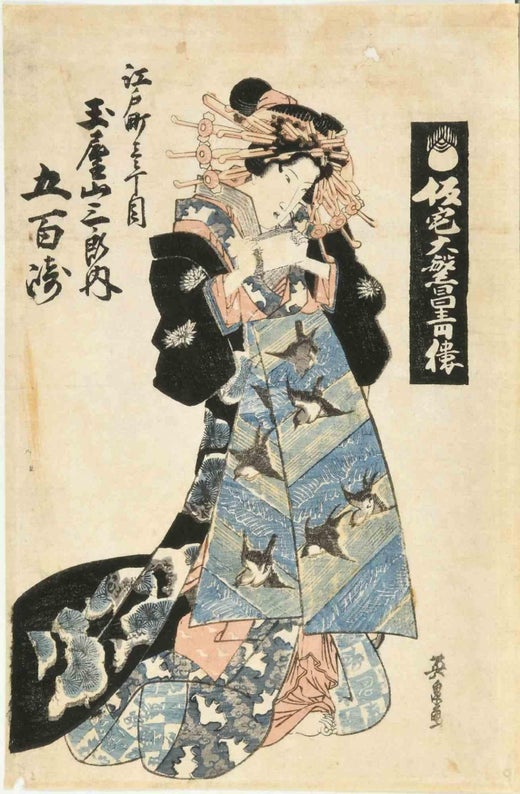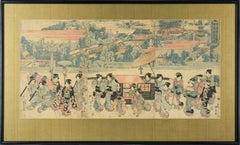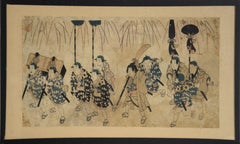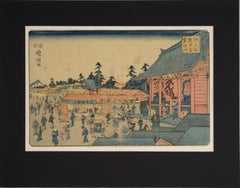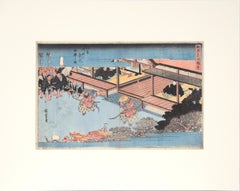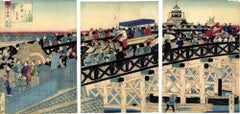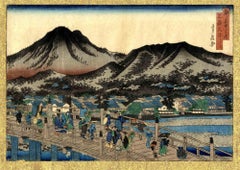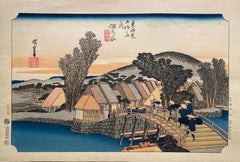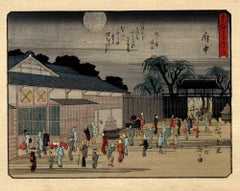Items Similar to Mitate of a Daimyo's Procession Crossing Ryogoku Bridge - Woodblock Print
Video Loading
Want more images or videos?
Request additional images or videos from the seller
1 of 15
Keisai EisenMitate of a Daimyo's Procession Crossing Ryogoku Bridge - Woodblock Printcirca 1840s
circa 1840s
$1,650
£1,279.07
€1,447.80
CA$2,361.50
A$2,576.93
CHF 1,337.58
MX$30,830.71
NOK 16,978.10
SEK 15,903.17
DKK 10,814.62
About the Item
Mitate of a Daimyo's Procession Crossing Ryogoku Bridge - Woodblock Print
Woodblock print of a procession by Keisai Eisen (Japanese, 1790–1848). Terrific triptych of a procession of young women crossing Edo Bridge in Edo in a parody of a traditional daimyo's procession. At the right, women carrying large trunks over their shoulder lead the way, followed by two yakko or footmen with striped collars carrying tall standards. In the center, a princess rides in an elegant palanquin surrounded by beauties. The river below is busy with boat traffic. Before 1842 edition.
Presented in a new black mat.
Mat size: 24"H x 36"W
Paper size: 18"H x 31"W
Keisai Eisen (Japanese, 1790–1848) was born in Edo into the Ikeda family, the son of a noted calligrapher. He was apprenticed to Kanō Hakkeisai, from whom he took the name Keisai, and after the death of his father he studied under Kikugawa Eizan. His initial works reflected the influence of his mentor, but he soon developed his own style.
He produced a number of surimono (prints that were privately issued), erotic prints, and landscapes, including The Sixty-nine Stations of the Kiso Kaidō, which he started and which was completed by Hiroshige. Eisen is most renowned for his bijin-ga (pictures of beautiful women) which portrayed the subjects as more worldly than those depicted by earlier artists, replacing their grace and elegance with a less studied sensuality. He produced many portraits and full-length studies depicting the fashions of the time.
In addition to producing a prolific number of prints, he was a writer, producing biographies of the Forty-seven Ronin and several books, including a continuation of the Ukiyo-e Ruiko (History of Prints of the Floating World), a book which documented the lives of the ukiyo-e artists. His supplement is known as "Notes of a Nameless Old Man."
- Creator:Keisai Eisen (1790 - 1848, Japanese)
- Creation Year:circa 1840s
- Dimensions:Height: 24 in (60.96 cm)Width: 36 in (91.44 cm)Depth: 0.25 in (6.35 mm)
- Medium:
- Movement & Style:
- Period:
- Condition:Significant tonal ageing. Some spots of discoloration.
- Gallery Location:Soquel, CA
- Reference Number:Seller: DBH90771stDibs: LU54214141092
Keisai Eisen
Keisai Eisen was a Japanese ukiyo-e artist who specialized in bijin-ga. His best works, including his ōkubi-e, are considered to be masterpieces of the "decadent" Bunsei Era (1818–30). Eisen was also known as Ikeda Eisen and wrote under the name of Ippitsuan.
About the Seller
5.0
Platinum Seller
Premium sellers with a 4.7+ rating and 24-hour response times
Established in 1986
1stDibs seller since 2014
3,038 sales on 1stDibs
Typical response time: <1 hour
- ShippingRetrieving quote...Shipping from: Soquel, CA
- Return Policy
More From This Seller
View AllThe Pilgrimage Procession to Kinryuzan Temple at Asakusa in the Eastern Capital
By Kuniyasu
Located in Soquel, CA
Japanese Parade - Woodblock Print
Japanese woodblock print by Utagawa Kuniyasu (歌川 国安) (Japan, 1794–1832). Japanese women, dressed in blue and red kimonos, are the focal point. A vi...
Category
Mid-19th Century Edo Figurative Prints
Materials
Paper, Ink, Woodcut
Festival Procession Of A Daimyo - Original Woodblock Print
Located in Soquel, CA
Procession Of A Daimyo - Original Woodblock Print
Original woodblock print depicting the procession of a Daimyo. Ten Japanese soldiers are seen as they aid in transporting the Daimy...
Category
Late 18th Century Edo Figurative Prints
Materials
Ink, Wood Panel, Rice Paper
"The Kaminarimon at the Kanseon Temple in Asakusa" - Original Japanese Print
Located in Soquel, CA
"The Kaminarimon at the Kanseon Temple in Asakusa" - Original Japanese Print
Japanese Print "The Kaminarimon at the Kanseon Temple in Asakusa", from the series "Famous Places in Ed...
Category
1850s Showa Figurative Prints
Materials
Rice Paper, Woodcut
Sumiyoshi: Dengaku dance performed during an Onda ceremony - Woodblock Print
By Utagawa Hiroshige
Located in Soquel, CA
Sumiyoshi: Dengaku dance performed during an Onda ceremony - Woodblock Print
Bright woodblock print by Utagawa Hiroshige (Japanese, 1797-1858). In this scene, two dancers with swords and fans are facing each other, in the center of a courtyard. There are spectators surrounding them, including nobles in black clothing on a balcony.
Presented in a new off-white mat with foamcore backing.
Mat size: 16"H x 20"W
Paper size: 9.63"H x 14.5W"
Utagawa Hiroshige (1797-1858, sometimes called Ando Hiroshige) was the second of the two great masters of the Japanese landscape woodblock print...
Category
1830s Edo Figurative Prints
Materials
Ink, Rice Paper, Woodcut
"First Horse Day, 1896" - Chiyoda Palace - Japanese Woodblock by Chikanobu Yoshu
By Toyohara Chikanobu
Located in Soquel, CA
"First Horse Day, 1896" - Chiyoda Palace - Japanese Woodblock by Chikanobu Yoshu
Colorful and expressive court scne by Toyohara Chikanobu,"Yoshu" (Japanese, 1838-1912).
This is the r...
Category
1890s French School Figurative Prints
Materials
Ink, Rice Paper, Woodcut
"Pictures Of Noh" - 1922 Original Japanese Woodblock Print
Located in Soquel, CA
"Pictures Of Noh" - 1922 Original Japanese Woodblock Print
Original Japanese woodblock print by Tsukioka Kogyo (Japanese, 1869-1927...
Category
1920s Edo Figurative Prints
Materials
Ink, Rice Paper, Woodcut
$568 Sale Price
20% Off
You May Also Like
Nihonbashi Bridge - Woodcut Print by Utagawa Yoshitora - 1875
By Utagawa Yoshitora
Located in Roma, IT
Scene on the Nihonbashi Bridge is an artwork realized in 1875 by Utagawa Yoshitora.
Woodcut print triptych. Signed: Mosai ga. Publisher: Sawamuraya...
Category
1870s Modern Figurative Prints
Materials
Woodcut
The Sanjo Bridge - Woodcut by Hasegawa Sadanobu - 1858
By Hasegawa Sadanobu I
Located in Roma, IT
The Sanjo Bridge is an original artwork realized in 1858 by Hasegawa Sadanobu (1809 - 1879).
Chuban yokoe.
From the series "Miyako meisho no uchi" (Famous views of the Imperial Ca...
Category
1850s Modern Figurative Prints
Materials
Woodcut
'Shinmachi Bridge', After Utagawa Hiroshige 歌川廣重, Ukiyo-e Woodblock, Tokaido
By Utagawa Hiroshige (Ando Hiroshige)
Located in Santa Cruz, CA
An ink on paper, Nishiki-e and Yoko-e woodblock landscape showing a panoramic view of Shinmachi Bridge, Hodogaya, circa 1850. Signed in Kanji upper left, "Hiroshige Ga" for Utagawa (...
Category
Mid-20th Century Landscape Prints
Materials
Sumi Ink, Washi Paper
Kyoka-Tokaido - Woodcut after Utagawa Hiroshige -1925
By Utagawa Hiroshige
Located in Roma, IT
Kyoka-Tokaido is an original modern artwork realized after Utagawa Hiroshige (1797 – 12 October 1858) in 1925.
Woodcut Print Chuban Yokoe Format.
Repri...
Category
1920s Modern Figurative Prints
Materials
Woodcut
Parade - Woodblock Print by Utagawa Kunisada - Mid-19th Century
By Utagawa Kunisada (Toyokuni III)
Located in Roma, IT
Celebratory Parade is an original Woodcut print realized in mid 19th century after Utagawa Kunisada.
Good condition and Beautiful colored woodblock print.
This wonderful modern a...
Category
Mid-19th Century Modern Figurative Prints
Materials
Woodcut
Kyoka-Tokaido - Woodcut after Utagawa Hiroshige -1925
By Utagawa Hiroshige
Located in Roma, IT
Kyoka-Tokaido is an original modern artwork realized after Utagawa Hiroshige (1797 – 12 October 1858) in 1925.
Woodcut print Chuban Yokoe Format. Signed...
Category
1920s Modern Figurative Prints
Materials
Woodcut
$311 Sale Price
24% Off
More Ways To Browse
Japanese Triptych
Keisei Eisen On Sale
Die Schaffenden
Diego Rivera Print New York Graphic Society
Foujita Woodcut
Francois Langlois
G Barbier
George Bellows Lithographs
George Harrison Marks
George Rouault Woodcut
Gerard Dou
Giacometti Annette
Giorgio Morandi Etching
Goupil Prints
Henry Moore Sculptural Ideas
Hermes Paris Rue Du Faubourg Saint Honore
Hockney Glasses
Hockney Olympic
